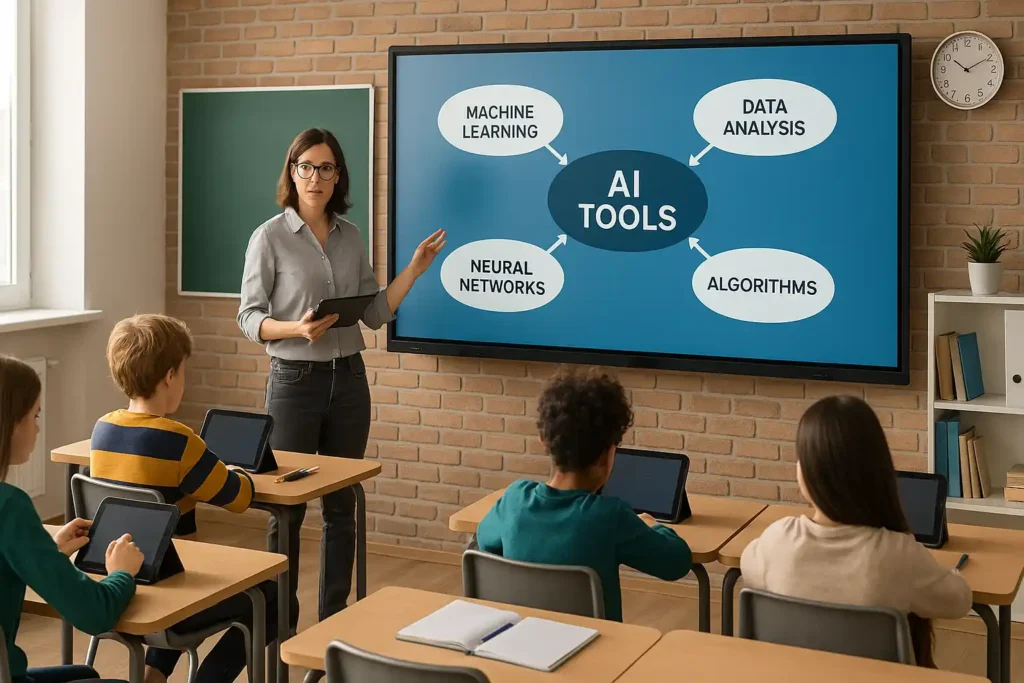How AI in Education Is Transforming the Classroom is something many teachers are starting to ask. And it’s a great question. Not long ago, artificial intelligence (AI) sounded like something out of a movie. Today, it’s already in our schools, helping teachers, students, and even parents in ways we never imagined.
Maybe you’re curious, or even a little afraid of this change. That’s totally normal. But the truth is: AI is not here to replace anyone — it’s here to help. And if used wisely, it can be a powerful ally in making learning easier, more fun, and more personalized.
Let’s talk about this in a simple way, with examples from real life, so that everyone — whether you’re tech-savvy or not — can understand and see the benefits.
How AI in Education Is Transforming the Classroom
We’re living in a digital age, and education is evolving too. Artificial Intelligence is bringing new possibilities that just a few years ago would seem impossible.
Let’s see how this transformation is happening in practice.
What Is AI and How Does It Work in Schools?
AI is like a super-smart assistant that learns from data. Imagine having a helper that pays attention to each student’s progress, suggests what they need to study next, or even helps with correcting tests.
AI in schools can:
- Analyze how students are doing.
- Give feedback in real-time.
- Suggest exercises suited to each student’s needs.
- Help teachers organize lesson plans.
- Translate texts or voice messages for students who speak other languages.
And all of this happens quickly and automatically. It’s like having extra support in the classroom — but digital.
Real-Life Examples of AI Helping in Classrooms
Here are some simple, real situations where AI is already making a difference:
1. Personalized Learning
Every student learns in their own way. Some are fast, some need more time. AI tools like Khan Academy and Duolingo adapt to each student’s pace, offering exercises based on how well they’re doing.
2. Help with Homework and Corrections
There are tools that automatically correct math problems or essays. This saves time for the teacher and gives instant feedback to students.
3. Supporting Students with Disabilities
AI apps can read texts aloud, convert speech into text, and even describe images. For students with visual or hearing impairments, this is a big win.
4. Language Learning and Translation
Apps powered by AI can translate entire sentences in seconds. That helps students who recently arrived in the country and still don’t speak the language well.
What Are the Benefits of AI for Teachers?
Many teachers worry that AI might replace them. But here’s the truth: AI cannot replace the warmth, creativity, and emotional intelligence of a human teacher. Instead, it supports and simplifies the work.
Some benefits include:
- Saving time with automatic grading.
- Better planning, thanks to student performance data.
- Focusing on what really matters: the students.
- Engaging lessons using smart tools that make learning more fun.

How AI Helps Students Learn Better
Students today are used to screens and fast information. AI meets them where they are.
Here’s how students benefit:
- More personalized help: Each student gets content that matches their level.
- Faster feedback: No need to wait a week to know how they did on a test.
- Motivation: Many AI platforms use games and rewards to make learning exciting.
- Safe environment to make mistakes and learn at their own pace.
Is AI Easy to Use for Teachers Who Aren’t Tech Experts?
Yes! Most tools are simple, with step-by-step instructions. You don’t need to be a tech genius.
Some examples of easy-to-use platforms:
- ChatGPT: Can help generate class ideas, summaries, or writing prompts.
- Google Classroom: Now has AI suggestions to organize content and tasks.
- Quizizz and Kahoot!: Use AI to create fun quizzes in minutes.
Even if you’re just starting out with technology, AI is built to support — not overwhelm — you.
What Are the Risks or Concerns About AI in Education?
Nothing is perfect, and with AI, we need to be careful too.
Some concerns include:
- Data privacy: It’s important to protect student information.
- Over-reliance on machines: Students and teachers still need human interaction.
- Equal access: Not every school has the same access to technology.
But with proper use and responsible choices, the benefits outweigh the risks.
Key Points About How AI in Education Is Transforming the Classroom
- AI helps personalize learning and adapts to each student’s needs.
- Teachers save time and can focus more on their students.
- Students get faster, more useful feedback.
- Tools are easy to use, even for beginners.
- We must stay alert to ethical and privacy concerns.
Conclusion
AI in education is not science fiction. It’s real, it’s here, and it’s making a difference. While no machine will ever replace the heart of a teacher, these tools can lighten the load and make learning more accessible for everyone.
So instead of fearing AI, let’s embrace it — step by step. Even small changes can have a big impact on students’ lives and your daily routine as a teacher.
What do you think? Have you used AI in your classroom? Tell us in the comments — your experience can help inspire others!

